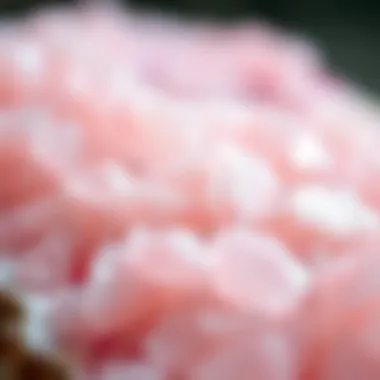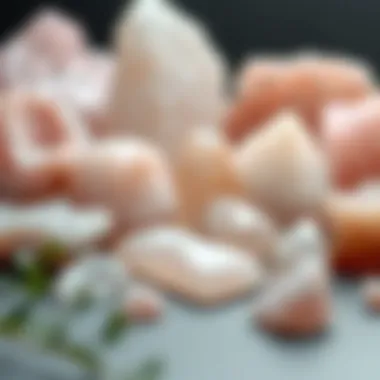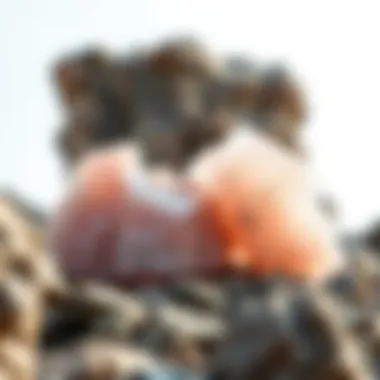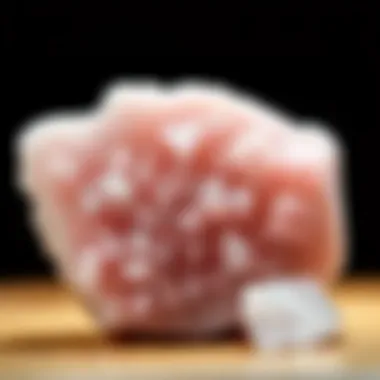Expert Guide to Identifying Raw Rose Quartz


Intro
History and Origins
Overview of Collectibles, Rocks, and Fossils
Rocks and minerals have always held a special place in human history. Raw rose quartz is no exception, often collected for its beauty and believed metaphysical properties. Historically, gemstones like rose quartz have found their way into jewelry and artifacts, tracing back thousands of years to ancient civilizations. From the Egyptians who adorned themselves with amulets, to the Romans who believed in the gemstone’s power to foster love, rose quartz has traversed time as a coveted collectible.
Historical Significance and Cultural Impact
Rose quartz has found its way into various cultures, becoming a symbol of love, healing, and self-acceptance. In the classical era, it was often used in crafting sculptures and decorative items. The belief that rose quartz can enhance emotional well-being has led to its widespread use in the realm of holistic healing. Even today, you’ll find enthusiasts seeking it for its purported benefits, which range from fostering romantic relationships to promoting inner peace. This rich history adds depth to its appeal, making it more than just a pretty rock; it’s a cherished part of the collective human experience.
Identification and Classification
Guide to Identifying Rocks and Fossils
When evaluating raw rose quartz, there are a few key aspects to inspect:
- Color: A characteristic light pink hue is typical, but variations can occur. Look for a consistent and vibrant color throughout the piece.
- Transparency: Genuine rose quartz is typically translucent. If it’s entirely opaque, there may be cause for skepticism.
- Texture: The surface may have a smooth feel due to natural weathering, often with a few minor blemishes or inclusions that add character.
To further ensure authenticity, you can employ various tests:
- Visual Examination: Examine the stone under different lighting to check for any inconsistencies.
- Scratch Test: True rose quartz can scratch glass but will not show deep scratches itself; tests should be done cautiously.
Common Types and Variations
While rose quartz is relatively straightforward to identify, it’s worth noting that variations exist:
- Strawberry Quartz: This variety contains inclusions that lend a red or pink hue, often giving it a sparkly appearance.
- Pink Quartz: Sometimes confused with rose quartz, it often has a more solid pink tone and may be less desirable.
In your quest for genuine specimens, you may encounter imitations made from glass or other materials. Recognizing these differences is vital in making informed collecting decisions.
“Knowledge is power. In the world of collectible minerals, expertise will separate your collection from the average.”
Expanding your understanding of raw rose quartz can enhance your appreciation and make your efforts in collecting all the more rewarding. With the knowledge gained from this article, you’ll be one step closer to mastering the identification of this beautiful mineral. For further reading and more tips on geological exploration, check out Wikipedia and Britannica for a deeper dive into the world of gemstones.
Understanding Rose Quartz
Understanding rose quartz is fundamental for any serious collector or enthusiast of minerals and crystals. At its core, this pink-hued gemstone is not only a striking addition to any collection but also carries a wealth of historical and geological significance. Knowledge about rose quartz equips collectors with the tools to identify authentic specimens versus imitations, thereby ensuring that their investments are both valuable and ethically sourced.
The Origins of Rose Quartz


Rose quartz is believed to have originated over 2,500 years ago. It can be found in numerous locations across the globe, from Brazil to Madagascar, and even parts of the United States. The tales surrounding its origin are as rich as its color, often linked to various myths and legends. For instance, ancient Egyptians are said to have used rose quartz as a symbol of love and beauty, even making face masks from it to maintain youthful skin.
The formation process of rose quartz involves a cooling period deep within the earth’s crust where silica and other elements coalesce over millions of years. Understanding where rose quartz comes from allows collectors to appreciate its geological background, which in turn enhances the significance of each piece.
Geological Composition
The composition of rose quartz primarily includes silica, a fantastic mineral known for its ability to form stunning crystals. Composed mainly of silicon dioxide, it features trace elements like titanium or iron that impart its characteristic pink hue. The intensity of color can vary tremendously, with some specimens appearing almost translucent while others exhibit a deeper, more opaque appearance. Collectors should be aware that the geological environment and the conditions under which the quartz crystallizes play pivotal roles in its visual characteristics.
ul> li>strong>Silica Content:strong> Silica is the backbone of rose quartz, making up nearly 100% of its structure.li> li>strong>Trace Elements:strong> Elements like manganese can lead to various shades of pink.li> li>strong>Formation Zone:strong> Commonly found in granitic rocks, which provides clues to its authenticity.li> ul>
Historical Uses
Throughout history, rose quartz has been attributed to a variety of uses beyond its appeal in jewelry-making. In ancient China, rose quartz was carved into the most intricate designs, often for decorative wear. It was also utilized in healing practices, believed to foster emotional balance and promote love. Its metaphysical properties are still widely discussed today in spiritual communities.
"Rose quartz serves not just as a beautiful stone but also as a conduit for emotional healing, representing unconditional love."
Collectors should consider not only the aesthetic attractions but also the cultural importance embedded in each stone. Understanding historical uses can enrich a collector's appreciation and inform their discussions about rose quartz in both casual and formal settings.
Physical Characteristics
Understanding the physical characteristics of raw rose quartz is vital for anyone looking to identify this unique gemstone accurately. These characteristics not only help in differentiating rose quartz from other minerals but also offer insights into its origin and quality. Collectors and enthusiasts can gain a deeper appreciation for this mineral by recognizing its distinctive traits. Focusing on aspects like color, transparency, and texture can enhance your ability to select authentic specimens, ultimately fostering a more rewarding collecting experience.
Color Variations
Color variations in rose quartz can range from soft, pale pink to deeper shades with more vivid hues. The intensity of the color often correlates with the quality of the crystal and its impurities, including titanium or iron that may contribute to the vibrancy. Natural rose quartz frequently exhibits a cloudiness or haziness rather than perfect transparency due to its unique formation process.
Different shades can be indicative of the specific location where the quartz was sourced. For instance, Brazilian rose quartz may present brighter colors compared to the more subdued tones found in some African deposits. It’s also worth noting that some pieces can even display a subtle banding effect, adding another layer of intrigue. Recognizing these color distinctions can be crucial for those looking to authenticate their specimens.
As you examine rose quartz, pay attention to any mottled or variegated aspects. This can indicate a genuine stone rather than an imitation that often strives for uniformity. The color can truly speak volumes about the stone’s origin and authenticity, making it a critical element in your evaluation.
Transparency Levels
The transparency levels of raw rose quartz can vary significantly based on its purity and the extent of inclusions. Typically, you'll find that natural rose quartz has a translucent appearance, allowing light to pass through but scattering it within the stone. This gives the gem its characteristic dreamy quality.
High-quality specimens may exhibit a more pronounced transparency, revealing delicate shadows and hues, while lesser quality options might appear more opaque or cloudy. An important note to consider is that some imitations will attempt to mimic the milky appearance of authentic rose quartz; hence, scrutinizing the light play within the stone can be critical. If you hold a piece to the light and it glows delicately without sharp edges, it most likely is genuine, while harsh or glaring light can hint at a synthetic origin.
Surface Texture
When it comes to the surface texture, raw rose quartz is generally uneven and may display natural roughness. Authentic pieces often bear the marks of their mineral journey, such as small grooves or chips that contribute to their charm. In contrast, imitations tend to have smoother textures that can mislead collectors.
Examining the surface can also yield details regarding the mineral's internal composition. For instance, natural stones may have tiny bubbles or fracturing patterns known as "fissures" formed during the cooling and solidifying process. When inspecting a piece, take it in your hand; the tactile experience can reveal important details that your eyes might not catch alone.
The surface texture doesn’t simply embellish the beauty of the stone — it serves as a fingerprint, telling its unique story.


By honing your skills in recognizing these key physical characteristics, you’ll be well on your way to discern genuine rose quartz from its many imitators. The subtleties in color, transparency, and texture are not just superficial attributes; they serve as gateways into understanding the essence of each specimen.
Identifying Authenticity
When it comes to collecting raw rose quartz, the credibility of your specimen is paramount. In an age rife with reproduction and imitation, knowing how to identify authentic rose quartz not only helps safeguard your investment but also deepens your appreciation of the stone's inherent beauty and energy. Authenticity can often be discerned through various tests and careful observation of several key characteristics, which bring forth tangible benefits for a discerning collector. Thus, the underlying importance of identifying authenticity lies in the true connection to the mineral's origins and the confidence it instills in one's collection.
Weight and Density Tests
One of the primary methods for gauging the authenticity of rose quartz is by conducting weight and density tests. Rose quartz exhibits a specific gravity ranging from 2.6 to 2.7. Here's how you can perform this test:
- Weigh the Sample: Start by weighing your rose quartz specimen on a reliable scale. Take note of the weight in grams.
- Water Displacement Method: Fill a graduated container with a known volume of water. Gently immerse your specimen and observe the increase in water level, which gives you the volume of the stone in cubic centimeters.
- Calculate Density: To find the density, use the formula:[ Density = \fracWeightVolume ]
If your readings align with the density range of genuine rose quartz, you may have a real specimen in hand. If not, it warrants further scrutiny.
Pleochroism and Color Shift
Another captivating element to explore is pleochroism, a phenomenon in which some materials display different colors when viewed from different angles. While authentic rose quartz generally shows a uniform pink hue, there can still be subtle shifts in color depending on the light's angle. When examining your specimen:
- Use Natural Light: Ensure you inspect it under daylight or a white LED light. As you rotate and tilt the sample, observe if it maintains its color. If it exhibits distinct changes in color, you might be looking at a dyed or synthetic product.
- Note Color Intensity: Authentic rose quartz typically possesses a soft hue. If it appears overly vibrant or unnatural, that’s a major red flag.
Checking for Inclusions
Lastly, inclusions can serve as telltale signs of authenticity. While many gemstones are flawless, authentic rose quartz often contains natural characteristics that speak to its geological history. To check for inclusions:
- Magnification: Utilising a jeweler’s loupe or a microscope, observe the stone's interior. Look for unique formations, such as tiny air bubbles, or a fibrous structure – these are indicative of natural formations.
- Natural Irregularities: Authentic rose quartz may show some minor scratches or flecks, setting it apart from the perfection of glass imitations.
Remember, patience is key. The best collectors take time to learn the ropes and refine their skills.
Common Imitations
The allure of rose quartz has led to the creation of several imitations that may deceive even experienced collectors. Understanding these common imitations is vital for anyone looking to acquire genuine specimens. Recognizing these fakes not only aids in purchasing decisions but also enhances one’s appreciation for the genuine article. By familiarizing oneself with these impostors, collectors can avoid falling prey to common scams, thus ensuring that their collections are authentic and valuable.
Glass Imitations
Glass imitations often masquerade as real rose quartz due to their similar appearance. These items can be produced in a range of colors and can mimic the milky translucence characteristic of authentic rose quartz. However, there are distinct clues that can help differentiate between glass and natural stone.
- Weight: Glass is usually significantly lighter than genuine rose quartz. If you hold a piece and it feels surprisingly light for its size, you might be looking at a glass imitation.
- Bubbles: Unlike raw rose quartz, which may have natural inclusions, glass can often contain small air bubbles trapped within it. A closer inspection with a loupe can reveal these imperfections.
- Temperature: When you hold a piece of authentic rose quartz, it feels slightly cooler to the touch than glass. This can be a telltale sign, especially in warmer environments.
Collectors should exercise caution and consider these factors when assessing potential purchases.
Synthetic Rose Quartz


Synthetic rose quartz is another common imitation, created in laboratories to replicate the appearance and properties of natural stone. While these synthetics can possess some similar visual characteristics, there are key differences to look for.
- Color Consistency: Synthetic rose quartz often displays a uniformity in color that is rare in natural specimens. If you spot an unusually consistent hue throughout, it’s likely synthetic.
- Surface Quality: Examine the surface closely. Synthetics tend to have a smoother texture, without the natural imperfections found in authentic rose quartz. Real specimens may exhibit slight variations or inclusions that tell a more intricate story of their formation.
- Certification and Pricing: When purchasing rose quartz, inquire about authentication. Reputable dealers often provide certification of authenticity for natural stones. If the price seems too good to be true, it likely is.
"The beauty of collecting lies not just in the acquisition, but in the understanding of what is truly genuine."
Synthetic stones can be more affordable, but they don’t carry the same appeal or metaphysical properties as natural gems. Knowledge is power in the realm of collecting, ensuring that enthusiasts always make informed choices.
Evaluation Techniques
Evaluation techniques play a crucial role in identifying raw rose quartz. By employing these methods, collectors can distinguish authentic specimens from fakes or inferior material. Understanding how to evaluate rose quartz not only enhances your collection but also deepens your appreciation for this stunning mineral.
Effective evaluation techniques involve careful inspection and tactile examination. Notably, using tools designed for close examination can reveal intricacies that the naked eye often misses. Mastering these tomes allows a collector to gain confidence in their assessments.
Using a Loupe for Inspection
A loupe, or jeweler's loupe, is an essential tool in the arsenal of any stone enthusiast. Its magnifying power enables the user to scrutinize the minutiae of the crystal’s surface. When looking through a loupe, you can observe the texture, transparency, and potential inclusions without the hindrance of distance.
- Positioning: Focus on a well-lit area, placing the rose quartz under the lens. Aim for about 12 inches distance from your eye. This distance allows optimal clarity.
- Inclusions Matter: Pay attention to any internal characteristics. Natural rose quartz typically contains tiny imperfections, such as needles of rutile or other minerals. These are telltale signs of authenticity.
- Texture Assessment: The surface should feel smooth but not overly polished. Overly polished specimens could indicate a synthetic source.
The clarity provided by the loupe allows an assessment that is not simply visual; it becomes tactile. This tactile feedback can guide your instincts in identifying authentic rose quartz.
Polishing and Scratch Tests
Polishing and scratch tests are hands-on methods that many collectors use to assess the authenticity of rose quartz. These techniques delve deeper into the physical properties that characterize genuine specimens.
- Polishing Test: Lightly polishing the surface with a microfiber cloth can reveal a great deal about the stone. Authentic rose quartz may not show any drastic changes with polishing, but synthetic alternatives might. This test helps in comparative assessments against known samples.
- Scratch Test: The hardness of rose quartz sits at a 7 on the Mohs scale. Using a material of known hardness, attempt a light scratch on a less conspicuous area. If the surface remains unblemished, you might have the real deal. However, if scratches are noticeable, proceed with caution as this could indicate a counterfeit product.
- Complementary Techniques: Pair the scratch test with the loupe inspection. There may be instances where scratches reveal underlying issues, leading to an informed conclusion about the stone's authenticity.
In summary, evaluation techniques enhance not just your ability to differentiate rose quartz from imitations but also enrich the overall experience of being a collector. By committing to evaluating raw rose quartz with these methods, one can forge a stronger connection with this captivating mineral.
Finale
As we wrap up this exploration into the world of raw rose quartz, it's essential to reflect on the significance of knowing how to identify this beloved mineral. Whether you're a seasoned collector or just dipping your toe into the gem world, understanding how to recognize genuine rose quartz can greatly enhance your experience with this stunning crystal.
Recap of Key Identification Methods
Let’s summarize the vital techniques discussed in this article:
- Weight and Density Tests: True rose quartz has specific density and weight characteristics that differentiate it from imitations. Using a scale can help you confirm the authenticity of your specimen.
- Pleochroism: While most rose quartz displays a consistent color, some may show subtle shifts in hue depending on the angle of light. This can be a telling sign of authenticity.
- Inclusions: A genuine specimen may contain natural inclusions or imperfections, which adds to its uniqueness. Examine the stone closely for these signs using a loupe.
- Using a Loupe for Inspection: This simple magnifying tool allows collectors to closely inspect the surface and internal structure of the quartz. You’d be surprised at what you might discover!
- Polishing and Scratch Tests: Knowing how the quartz behaves when scratched or polished can reveal whether you're dealing with the real thing or a mere imitation.
Having these methods at your disposal will empower you to make informed decisions when sourcing rose quartz, whether in the wild or at a local market. Trust in your gathered knowledge as you navigate the rich tapestry of mineral collecting.
Importance of Knowledge in Collecting
Knowledge stands as a cornerstone in the realm of mineral and fossil collection. With the ever-growing market for semi-precious stones, it is all too easy to be misled by lookalikes or artificially enhanced stones. Understanding the nuances of rose quartz not only protects your investments but also deepens your appreciation for these geological marvels.
- Academic Resources: Utilizing resources such as en.wikipedia.org and britannica.com can deepen your foundational knowledge about rose quartz.
- Community Engagement: Engaging with communities on platforms like reddit.com can provide real-world insights and experiences from fellow collectors.
- Workshops and Seminars: Attending local workshops can offer hands-on experience, allowing you to get familiar with various techniques that enhance your identification skills.
By building a solid foundation of knowledge, you position yourself as an informed collector who can distinguish between the authentic and the imitation. The trust in your expertise will not only save you dollars but also enrich your collecting journey. Armed with this understanding, may your pursuit of rose quartz be both successful and satisfying.



